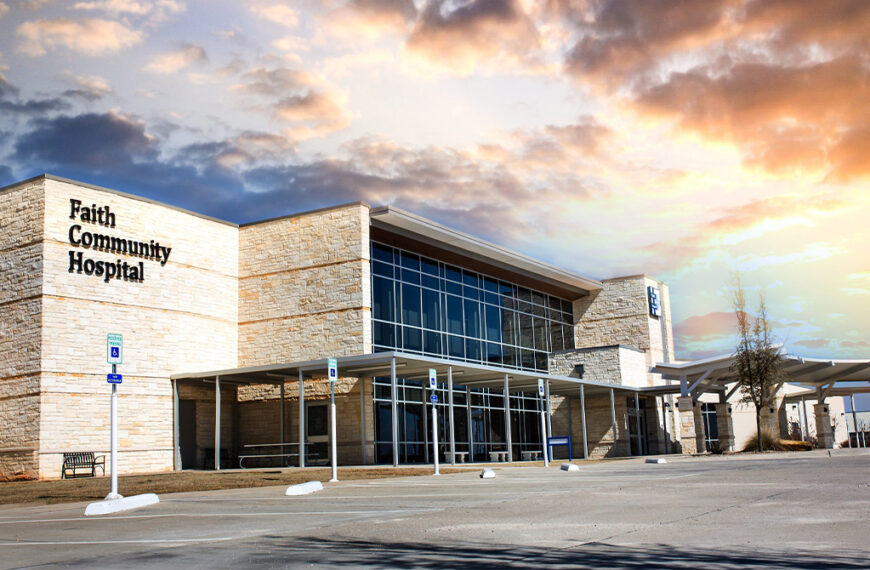The unique challenges of caring for populations tucked among open fields and rough two-lane roads haven’t lessened in the 12 years since National Rural Health Day came into being.
In fact, in Texas, the need for this day – commemorated on the third Thursday of each November – may be more acute than ever, with more than a quarter of Texas rural hospitals at risk of closure according to recent data.
The National Organization of State Offices of Rural Health (NOSORH) launched National Rural Health Day in 2011, doing so to highlight rural health care providers, state offices of rural health and other stakeholders in rural communities to “address the unique healthcare challenges that rural citizens face today and into the future.”
For the Texas Hospital Association, today is a reflection not only on those challenges, but also on the outsized role rural facilities play in their surrounding environment.

“It’s important that we remind people that hospitals aren’t just in the community providing the care. They’re also one of the top employers in the community – whether you’re urban or rural, but that’s particularly true in rural areas,” said Jennifer Banda, J.D., THA’s senior vice president of advocacy and public policy. “The hospital supports the clinics and the pharmacies and the outpatient providers. It all ties back to the hospital. So in those rural areas, it really is the lifeblood of the community.”
Recognition of the heroes – and the problems
Nationally, according to NOSORH, 61 million people live in rural communities. About 15% of Texas’ 30 million residents live in rural areas, served by 148 rural hospitals.

“Anything that gets us to take a more critical look at the role that rural hospitals play in our state is very important,” THA President/CEO John Hawkins said of National Rural Health Day. “We know coming out of the pandemic, in a lot of cases, those rural hospitals actually functioned as the public health infrastructure in their communities. They were certainly the front lines of dealing with the pandemic, but they also provided testing, vaccines, other resources for their community.
“So we know that without those hospitals, we wouldn’t have made it through the pandemic. It just reminded us what a critical role they play in the fabric of this state.”
Collectively, Texas’ rural facilities deal with a litany of issues that are either unique to the rural setting or exacerbated by it. A partial list: Cash-flow problems from limited tax revenue; shortages of nurses and other health care workforce personnel; the difficulty in recruiting physicians to remote areas; and the reimbursement delays and denials that the older populations in rural areas often encounter with Medicare Advantage, the commercial payer-run version of Medicare. Specialty coverage is yet another rural-specific challenge.
“It’s difficult sometimes to get the specialty doctors out in rural areas,” Banda noted. “When you’re a designated maternal care hospital or a designated neonatal hospital, you’re subject to rules on deploying specialty coverage within certain amounts of time. And in rural areas, it’s maybe hard to be there in a short period of time, and the rules need to account for that. Those are the type of weedy details we try to work to address.”
THA raised many of these problems in a recent letter responding to a U.S. House Ways & Means Committee request for information on improving health care access in rural and underserved areas. Earlier this year, rural struggles were on THA’s mind entering this year’s regular session of the Texas Legislature, following the 2022 release of the THA-commissioned Kaufman Hall report. Although its scope was on the financial pressures straining Texas hospitals as a whole, one of the report’s most troubling findings was specific to the state’s rural hospitals – 26% of them are at risk of closure, compared to 5% of urban hospitals.
Armed with that key data point, THA convinced lawmakers to maintain and boost key rural funding markers in the 2024-25 state budget. Some of the funding wins that should make a significant difference going forward: a $36 million annual increase for rural outpatient payments to bring reimbursements in line with costs, and $47 million over 2024-25 to triple add-on payments for Medicaid rural labor and delivery, from $500 to $1,500.
The need for innovation and conversation
Last week, Texas voters did their part for rural health care as well.
The theme of this year’s National Rural Health Day celebration is Innovation in Rural Health Care Delivery – a subject nowadays inextricable from using reliable internet access to close gaps in physical distance between physicians and providers. To that end, THA was elated by Texas’ overwhelming vote in favor of Proposition 8 on Nov. 7. The approved amendment to the Texas Constitution sets up a dedicated broadband infrastructure fund of $1.5 billion to expand high-speed internet access and “assist in the financing of connectivity projects.”
An estimated 7 million Texans lack internet access, and reducing that number will enable and enhance innovative care models in telehealth. In its letter to the House Ways & Means Committee, THA noted the benefits of expanded telehealth services during the COVID-19 pandemic, and advocated for the continuation of waivers and flexibilities for those care models. Banda notes the dedicated broadband funding will help remote rural hospitals with the difficulties in required specialty coverage.
The wide-ranging letter also noted THA’s support for permanent use of the federal Acute Hospital Care at Home program, another innovative pandemic-era boon for care that will be enhanced by more robust internet access.
As it recognizes and advocates for rural providers, THA continues to proactively solicit the voices of members representing those facilities, working to collect their feedback and encouraging their input on THA’s boards, councils and committees.
“We try to make sure that there’s a rural voice in the work that we’re doing, whether it’s on the CHIRP [Comprehensive Hospital Increase Reimbursement] Program, quality initiatives, Medicaid programs, behavioral health coverage,” Banda said. “Because the challenges are different in a rural area, and sometimes you have to innovate differently.”
Related articles from The Scope
Streamlining Patient Discharges: How RAPTR Saves Time & Money
Acadian Ambulance Service is proud to launch a new integrated…
Recognizing a Critical First Line of Defense: National Rural Health Day
In recent years, Texas has become widely recognized for its…
Rural Texas Hospital Goes Hollywood
When Hollywood – and one of TV’s preeminent creators of…
Hospital Week: A Tribute to Texas Hospitals
For over 100 years, Hospital Week has recognized the tremendous…
Texas Hospitals Going Above and Beyond on Charity, Indigent Care
Everyone needs and deserves medical care. Texas hospitals understand that…
Brad Holland: Rallying for Texas Hospitals
One year ago, THA was launching into the 2023 legislative…








